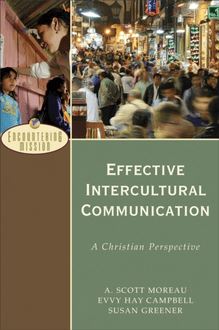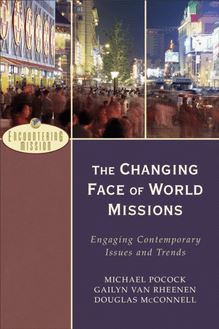Introducing World Missions (Encountering Mission) , livre ebook
229
pages
English
Ebooks
2015
Obtenez un accès à la bibliothèque pour le consulter en ligne En savoir plus
Découvre YouScribe en t'inscrivant gratuitement
Découvre YouScribe en t'inscrivant gratuitement
229
pages
English
Ebooks
2015
Obtenez un accès à la bibliothèque pour le consulter en ligne En savoir plus
Publié par
Date de parution
09 juin 2015
Nombre de lectures
0
EAN13
9781441224491
Langue
English
Poids de l'ouvrage
19 Mo
Publié par
Date de parution
09 juin 2015
Nombre de lectures
0
EAN13
9781441224491
Langue
English
Poids de l'ouvrage
19 Mo
A. Scott Moreau, series editor
A LSO IN THE S ERIES :
The Changing Face of World Missions: Engaging Contemporary Issues and Trends
Michael Pocock, Gailyn Van Rheenen, and Douglas McConnell
Encountering Missionary Life and Work: Preparing for Intercultural Ministry
Tom Steffen and Lois McKinney Douglas
Christianity Encountering World Religions: The Practice of Mission in the Twenty-first Century
Terry Muck and Frances S. Adeney
Encountering Theology of Mission: Biblical Foundations, Historical Developments, and Contemporary Issues
Craig Ott and Stephen J. Strauss with Timothy C. Tennent
Developing a Strategy for Missions: A Biblical, Historical, and Cultural Introduction
John Mark Terry and J. D. Payne
Effective Intercultural Communication: A Christian Perspective
A. Scott Moreau, Evvy Hay Campbell, and Susan Greener
Encountering the History of Missions: From the Early Church to Today
John Mark Terry and Robert L. Gallagher
Intercultural Discipleship: Learning from Global Approaches to Spiritual Formation
W. Jay Moon
© 2004, 2015 by A. Scott Moreau, Gary R. Corwin, and Gary B. McGee
Published by Baker Academic a division of Baker Publishing Group P.O. Box 6287, Grand Rapids, MI 49516-6287 www.bakeracademic.com
Ebook edition created 2015
Ebook corrections 04.30.2020, 12.06.2022
All rights reserved. No part of this publication may be reproduced, stored in a retrieval system, or transmitted in any form or by any means—for example, electronic, photocopy, recording—without the prior written permission of the publisher. The only exception is brief quotations in printed reviews.
Library of Congress Cataloging-in-Publication Data is on file at the Library of Congress, Washington, DC.
ISBN 978-1-4412-2449-1
Unless otherwise indicated, Scripture quotations are from the Holy Bible, New International Version®. NIV®. Copyright © 1973, 1978, 1984, 2011 by Biblica, Inc.™ Used by permission of Zondervan. All rights reserved worldwide. www.zondervan.com
In chapter 13, the section “Money as a Burden” is adapted from Gary R. Corwin, “The Root of All Kinds of Confusion,” Evangelical Missions Quarterly 38 (January 2002): 8–9; the section “Leadership as a Bad Word” is adapted from Gary R. Corwin, “Leadership as Pain-Bearing,” Evangelical Missions Quarterly 34 (January 1998): 16–17; and the section “Women in Mission” is adapted from Gary R. Corwin, “Women in Missions,” Evangelical Missions Quarterly 33 (October 1997): 400–401.
In chapter 17, the section “The Message of Short-Term Missions” is adapted from Gary R. Corwin, “The Message of Short-Term Missions,” Evangelical Missions Quarterly 36 (October 2000): 422–23.
Permission was granted for use of materials from the following sources:
Hiebert, Paul, and Frances Hiebert, eds. 1987. Case Studies in Missions . Grand Rapids: Baker.
Moreau, A. Scott, gen. ed. 2000. Evangelical Dictionary of World Missions . Grand Rapids: Baker.
O’Hara, Bill, and Carol O’Hara. 2002. “What about Cross-Cultural Marriage?” Online: https://web.archive.org/web/20060107064702/http:/www.missionsandmarriages.org/xculture.html [cited 24 July 2002]
Reapsome, Jim. 1999. Final Analysis: A Decade of Commentary on the Church and World Missions . Wheaton, IL: Evangelism and Missions Information Service.
Baker Publishing Group publications use paper produced from sustainable forestry practices and post-consumer waste whenever possible.
Dedicated to Gary McGee, brother in Christ and fellow pilgrim in mission, now present with the Lord
Contents
Cover 1
Series Page 2
Title Page 3
Copyright Page 4
Dedication 5
Preface 9
1. Missions in the Modern World 13
Part 1 Encountering Mission in the Scriptures 27
2. Encountering Mission in the Old Testament 29
3. Encountering Mission in the Gospels 41
4. Encountering Mission in the New Testament Church 53
5. Encountering Mission Theology 69
Part 2 Encountering Missions in History 85
6. Expansion in the Premodern Era, AD 30–1500 87
7. Expansion in the Era of Discovery and Colonialism, AD 1500–1900 109
8. Expansion to and from Every Continent, AD 1900–2000 129
Part 3 Encountering Missions as a Candidate 147
9. First Steps: Have You Been Called? 149
10. Missionary Preparation 161
11. Charting a Path from Here to There 179
Part 4 Encountering Missions as a Sent One and as a Sender 191
12. Personal and Family Issues 193
13. Strategic and Ministry Issues 209
14. Relating to People of Other Cultures 221
15. Relating to Churches and Other Shareholders 231
Part 5 Missions Encountering the Contemporary World 249
16. Communicating with People of Other Cultures 251
17. Missions Trends and Paradigm Shifts 265
18. Encountering the Religions of the World 281
19. Missions and the Future 295
Reference List 299
Subject Index 325
Scripture Index 334
Back Cover 337
Preface
Introducing World Missions was first published in 2004 and written for prospective missionaries as well as for those who are interested in missions but may serve in other capacities in God’s work. Since that time we have been gratified to see it used as a text in introductory missions courses in many colleges and seminaries around the world. Since the initial publication, many excellent introductions to mission have become available (e.g., Gailey and Culbertson 2007; Hawthorne and Winter 2009; Hoke and Taylor 2009; Tennent 2010; Sunquist 2013). We rejoice that those who are interested in diving into mission have so many great offerings from which to choose.
Additionally, even though only ten years have passed since the initial publication of Introducing World Missions , we have witnessed an explosion of ideas, practices, challenges, and opportunities in mission. Ideas not mentioned in the previous edition such as church-planting movements, orality, integral mission, and insider movements have all come to the fore over the decade—together with several hundred new books on mission and missions—mandating a revision of the text.
The idea of becoming a missionary can be exciting and frightening at the same time. Living in a remote location, learning a new language, and possibly being physically cut off from those at home are all daunting for many people. Forging new friendships across cultures, the thrill of seeing a new church planted and leadership developing, and helping God’s people grow and develop in their walk with Christ are all exciting prospects for the missionary. Doing all of this in an increasingly uncertain world filled with indifference or even danger is a sobering prospect.
Introducing World Missions was the first in a projected series of eight books focusing on mission from an evangelical perspective. To date seven have been published, including The Changing Face of Missions (2005), Encountering Missionary Life and Work (2008), Christianity Encountering World Religions (2009), Encountering Theology of Mission (2010), Developing a Strategy for Missions (2013), and Effective Intercultural Communication (2014).
We intend this book to be a general introduction to contemporary missions. Written as a textbook, it focuses on providing students in introductory missions courses with a broad overview as well as occasional deeper explorations. Typical introductory missions classes include not only prospective missionaries but also students who might not become missionaries themselves but need to understand contemporary missions as part of their anticipated pastoral roles. Although our focus here has been on the former, we have also written with the latter in mind.
The book is divided into five major sections through which mission is encountered. First comes the biblical and theological encounter, which lays the foundation for the rest of the book. In part 1 we argue that the evangelistic mandate of winning people to Christ must be at the core of any theology of mission that hopes to remain true to the biblical orientation. Contemporary practices and thinking about missions are best understood in light of their historical context, and in part 2 we provide an overview of the history of God’s work through the church in missions.
Introducing the contemporary student to mission requires pragmatic information in addition to the foundations laid, and in the last three parts of the book we tackle practical issues and current challenges from different perspectives. Part 3 explores missions from the viewpoint of the prospective missions candidate and others who share in the task. What does it mean to be called as a missionary, and what is involved in getting from here (the missionary’s home) to there (the country or location of service)? Part 4 carries the story further by looking at the challenges that will face any “sent one.” These span a spectrum of personal and family issues, strategic and ministry issues, and the requirements of adjusting to a new culture and all kinds of new relationships. Part 5 concludes the book with an exploration of contemporary challenges to missions, a survey of the missionary encounter with the non-Christian religions of the world, and a brief projection of what lies in the future for missions.
To supplement the text, we have added four additional sets of materials. They have been designed to help the teacher get the most out of the book.
First, most of the chapters include a case study. Case studies help the readers dig more deeply into a selected issue that fits the discussion in the chapter. Our case studies leave the reader with a dilemma for which a solution should be sought. For every case study in the book, there are numerous good solutions and numerous bad ones. Having students wrestle with the dilemmas presented in the case studies engages them in the learning process. Case dilemmas help students learn how to draw from theory in light of practical problems faced on the field.
If you are a teacher, we encourage you to use the case studies in ways that fit your objectives for the class. Students might write an essay on possible








